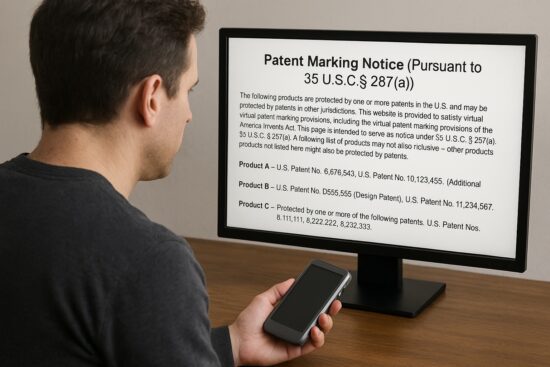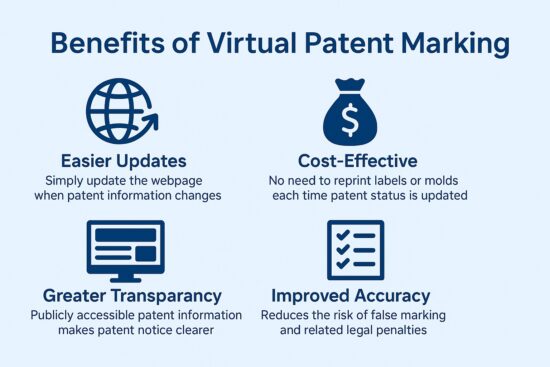
Patent owners have a legal incentive to mark their products with patent information to put the public on notice of their patent rights. Traditionally, this meant stamping or labeling products with patent numbers. However, virtual patent marking is a modern alternative that allows businesses to use a website to list associated patents for their products. This method was introduced by the Leahy-Smith America Invents Act of 2011 to simplify compliance with patent marking laws. Virtual patent marking is important because it provides the ability to recover damages from infringers and notice to the public in an efficient way.
Patent marking serves to give notice to the public that a product is protected by one or more patents. Marking a patented product (or its packaging) with the word “Patent” (or “Pat.”) and the patent number notifies others that the product is patented. Under U.S. law, this satisfies the constructive notice requirement, meaning that potential infringers are deemed aware of the patent, even if they are not actually aware of the patent. Constructive notice provides the patent owner with the ability to claim damages from the earliest possible date of infringement. Without proper marking, the patent owner may lose substantial damages for past infringement.
Before 2011, U.S. law only allowed physical marking: marking the product or its label with patent numbers. The America Invents Act (AIA) changed this by adding virtual marking provisions to 35 U.S.C. § 287, the patent marking statute. Virtual patent marking allows patent owners to use the internet for providing patent notice. Instead of listing long patent numbers on the product, a company can mark the product with the word “Patent” or “Pat.” followed by a URL (web address) of a publicly accessible webpage that lists the relevant patents. This amendment was intended to modernize the marking process for the digital age, making it easier to update patent information and handle products covered by multiple patents. By introducing virtual marking, the AIA enabled businesses to efficiently provide patent marking notice without repeatedly altering product molds or packaging every time patent information changes.
The U.S. marking statute, 35 U.S.C. § 287(a), now explicitly permits virtual marking. It states that a patentee may give notice that an article is patented “either by fixing thereon the word ‘patent’ or ‘pat.’ together with the number of the patent, or by fixing thereon the word ‘patent’ or ‘pat.’ together with an address of a posting on the Internet, accessible to the public without charge, that associates the patented article with the number of the patent”. In other words, you can either stamp the patent number on the product or simply mark the product with a web address where the patent numbers are listed. If marking the product itself is not possible, e.g., due to size or nature of the article, the statute allows marking the packaging in a similar way. The virtual patent marking notice on the product typically looks like: “Patent: www.YourCompany.com/patents” or some other format. As long as the referenced webpage clearly associates each product with its applicable patent numbers, this constitutes proper notice under the law.
Crucially, the statute also provides a practical penalty for not marking: “In the event of failure so to mark, no damages shall be recovered by the patentee in any action for infringement, except on proof that the infringer was notified of the infringement and continued to infringe thereafter.” In plain terms, if you don’t mark your patented product, either physically or virtually, you cannot recover damages for infringement that happened before the infringer received actual notice of the patent, such as by formal notice letter or being served in a lawsuit. Patent owners are wise to mark products, as doing so provides constructive notice and preserves the right to recover full damages for past infringement.
Adopting virtual patent marking is straightforward and cost-effective. Here’s how a business can implement a virtual marking program:
By following these steps, even companies with many patents or frequently updated patent portfolios can efficiently comply with the virtual marking provisions.

Virtual patent marking offers several key advantages over traditional marking:
Overall, virtual marking provides the same legal benefit of constructive notice under § 287 as physical marking with more convenience and clarity.
To get the most out of virtual patent marking, companies should follow some best practices to ensure the notice is effective and legally sound:
By adhering to these practices, patent owners can maximize the benefits of virtual marking and avoid pitfalls that could undermine their patent rights.
Over the years, several court decisions (especially in the Federal Circuit, which hears patent appeals) have addressed issues with patent marking – including virtual marking – reinforcing how important compliance is. Below are a few notable insights from case law:
These cases underscore that courts take the marking statute seriously. Proper marking, including via a virtual patent marking notice, is often a deciding factor in how far back you can recover damages in an infringement lawsuit. Patent owners should treat marking as an important part of their enforcement strategy, not an optional technicality.
What does a virtual patent marking page actually look like in practice? Typically, the page will start with a notice explaining its purpose, followed by a list of products and patents. Here is a sample format inspired by how companies implement virtual marking:
Patent Marking Notice (Pursuant to 35 U.S.C. § 287(a)):
The following products are protected by one or more patents in the U.S. and may be protected by patents in other jurisdictions. This website is provided to satisfy virtual patent marking provisions, including the virtual patent marking provisions of the America Invents Act. This page is intended to serve as notice under 35 U.S.C. § 287(a). The following list of products may not be all-inclusive – other products not listed here might also be protected by patents. Each product below is associated with at least one U.S. patent.
- Product A – U.S. Patent No. 9,876,543; U.S. Patent No. 10,123,456. (Additional patents pending.)
- Product B – U.S. Patent No. D555,555 (Design Patent); U.S. Patent No. 11,234,567.
- Product C – Protected by one or more of the following patents: U.S. Patent Nos. 8,111,111; 8,222,222; 8,333,333.
In the example above, the opening paragraph uses phrasing commonly seen on patent marking pages, fulfilling the virtual patent marking notice requirements. It mentions the America Invents Act and cites the statute to be explicit about providing legal notice. It also uses the phrases “one or more patents” and “various jurisdictions,” because often companies want to cover international patent rights and make clear that the list is not exhaustive. Each of the products listed is associated with specific patent numbers. Notice that even design patents (which have a “D” prefix) are included. Design patents should be marked too, in either the same list or a separate section, but the marking statute applies to patented articles of any kind (utility patents, design patents, and plant patents). Also, noting “patents pending” for a product does not give legal protection for those pending applications, but it informs readers that more patents might be coming. If any patent application later issues as a patent, that number should be added to the list promptly.
Virtual patent marking is a powerful tool for U.S. patent owners, combining legal compliance with maximized patent protection. Notice of patented products can be established via a simple website listing, thereby achieving constructive notice under the law without the downsides of lengthy physical markings. It is clear in cases like Arctic Cat and Rembrandt that failing to mark can be a costly mistake that is easily avoided through diligent marking.
If you have questions regarding virtual patent marking or other patent matters, please contact our offices for a free consultation.
© 2025 Sierra IP Law, PC. The information provided herein does not constitute legal advice, but merely conveys general information that may be beneficial to the public, and should not be viewed as a substitute for legal consultation in a particular case.

"Mark and William are stellar in the capabilities, work ethic, character, knowledge, responsiveness, and quality of work. Hubby and I are incredibly grateful for them as they've done a phenomenal job working tirelessly over a time span of at least five years on a series of patents for hubby. Grateful that Fresno has such amazing patent attorneys! They're second to none and they never disappoint. Thank you, Mark, William, and your entire team!!"
Linda Guzman

Sierra IP Law, PC - Patents, Trademarks & Copyrights
FRESNO
7030 N. Fruit Ave.
Suite 110
Fresno, CA 93711
(559) 436-3800 | phone
BAKERSFIELD
1925 G. Street
Bakersfield, CA 93301
(661) 200-7724 | phone
SAN LUIS OBISPO
956 Walnut Street, 2nd Floor
San Luis Obispo, CA 93401
(805) 275-0943 | phone
SACRAMENTO
180 Promenade Circle, Suite 300
Sacramento, CA 95834
(916) 209-8525 | phone
MODESTO
1300 10th St., Suite F.
Modesto, CA 95345
(209) 286-0069 | phone
SANTA BARBARA
414 Olive Street
Santa Barbara, CA 93101
(805) 275-0943 | phone
SAN MATEO
1650 Borel Place, Suite 216
San Mateo, CA, CA 94402
(650) 398-1644. | phone
STOCKTON
110 N. San Joaquin St., 2nd Floor
Stockton, CA 95202
(209) 286-0069 | phone
PORTLAND
425 NW 10th Ave., Suite 200
Portland, OR 97209
(503) 343-9983 | phone
TACOMA
1201 Pacific Avenue, Suite 600
Tacoma, WA 98402
(253) 345-1545 | phone
KENNEWICK
1030 N Center Pkwy Suite N196
Kennewick, WA 99336
(509) 255-3442 | phone
2023 Sierra IP Law, PC - Patents, Trademarks & Copyrights - All Rights Reserved - Sitemap Privacy Lawyer Fresno, CA - Trademark Lawyer Modesto CA - Patent Lawyer Bakersfield, CA - Trademark Lawyer Bakersfield, CA - Patent Lawyer San Luis Obispo, CA - Trademark Lawyer San Luis Obispo, CA - Trademark Infringement Lawyer Tacoma WA - Internet Lawyer Bakersfield, CA - Trademark Lawyer Sacramento, CA - Patent Lawyer Sacramento, CA - Trademark Infringement Lawyer Sacrament CA - Patent Lawyer Tacoma WA - Intellectual Property Lawyer Tacoma WA - Trademark lawyer Tacoma WA - Portland Patent Attorney - Santa Barbara Patent Attorney - Santa Barbara Trademark Attorney